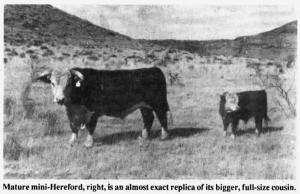This Texan Breeds Mini Hereford Cattle
 ✖  |
"I can raise 25% more beef on the same pasture with my miniature Herefords than with full-size cattle. They gain much more efficiently and reach market weight sooner than conventional size cattle," says Rust Largent, Fort Davis, Texas, who breeds mini Herefords that measure less than 40 in. tall and weigh under 700 lbs.
Largent has been breeding cattle for reduced size since 1970 in an effort to increase weight gain efficiency. His mini Hereford program kicked into high gear in 1980 when a bull was born with genetics that allowed the herd's frame size to be reduced at a phenomenal rate. Largent decided to continue reducing size, using an inbreeding program from five different bloodlines of the original herd. His 115-cow herd includes some cows that are less than 38 in. tall and weigh less than 500 lbs. - and size has been decreasing by as much as 3 in. in one generation. Largent keeps the heifers and feeds out the steers to prime or choice grade, selling them to individuals in his area.
"As far as I know my mini Herefords are the smallest registered Herefords in the world," says Largent, who has his entire herd registered with the American Hereford Association. "There's no dwarfism in the bloodlines of my mini Herefords, and there have been no reproductive problems or throwbacks to larger animals either."
Largent says some people consider his mini Herefords a novelty, but he considers them practical and economical. "Mini Here-fords can reach prime or choice grade at 14 months when they're fed for market. It takes a conventional size steer 20 to 22 months or longer," says Largent. "Because mini Here-fords don't have to be fed nearly as long to make choice grade, you can start feeding them a high corn ration sooner."
According to Largent, his cattle have a higher calf-to-cow weight ratio (percentage of calf weight to cow weight at weaning time). "Texas A & M University says that the national average calf to cow weight ratio is 35 to 40% compared to 65% for my mini Herefords. Texas A & M also says a cow's total nutritional intake is directly proportional to its body weight. If that's true, then two 6004). cows eat no more than one 1,200-lb. cow The 1,200-lb. cow puts on more weight, out not more efficiently. The combination of the higher calf-to-cow weight ratio and equality of nutritional in-take allows mini Herefords to produce 25% or more beef from a given pasture."
Largent started selling breeding animals earlier this year.
For more information, contact: FARM SHOW Followup, R. Rust Largent, Point of Rocks Ranch, Rt. 1, Box 20, Fort Davis, Texas 79734 (ph 915 426-3330).

Click here to download page story appeared in.
Click here to read entire issue
This Texan breeds mini hereford cattle AG WORLD Ag World 14-4-19 "I can raise 25% more beef on the same pasture with my miniature Herefords than with full-size cattle. They gain much more efficiently and reach market weight sooner than conventional size cattle," says Rust Largent, Fort Davis, Texas, who breeds mini Herefords that measure less than 40 in. tall and weigh under 700 lbs.
Largent has been breeding cattle for reduced size since 1970 in an effort to increase weight gain efficiency. His mini Hereford program kicked into high gear in 1980 when a bull was born with genetics that allowed the herd's frame size to be reduced at a phenomenal rate. Largent decided to continue reducing size, using an inbreeding program from five different bloodlines of the original herd. His 115-cow herd includes some cows that are less than 38 in. tall and weigh less than 500 lbs. - and size has been decreasing by as much as 3 in. in one generation. Largent keeps the heifers and feeds out the steers to prime or choice grade, selling them to individuals in his area.
"As far as I know my mini Herefords are the smallest registered Herefords in the world," says Largent, who has his entire herd registered with the American Hereford Association. "There's no dwarfism in the bloodlines of my mini Herefords, and there have been no reproductive problems or throwbacks to larger animals either."
Largent says some people consider his mini Herefords a novelty, but he considers them practical and economical. "Mini Here-fords can reach prime or choice grade at 14 months when they're fed for market. It takes a conventional size steer 20 to 22 months or longer," says Largent. "Because mini Here-fords don't have to be fed nearly as long to make choice grade, you can start feeding them a high corn ration sooner."
According to Largent, his cattle have a higher calf-to-cow weight ratio (percentage of calf weight to cow weight at weaning time). "Texas A & M University says that the national average calf to cow weight ratio is 35 to 40% compared to 65% for my mini Herefords. Texas A & M also says a cow's total nutritional intake is directly proportional to its body weight. If that's true, then two 6004). cows eat no more than one 1,200-lb. cow The 1,200-lb. cow puts on more weight, out not more efficiently. The combination of the higher calf-to-cow weight ratio and equality of nutritional in-take allows mini Herefords to produce 25% or more beef from a given pasture."
Largent started selling breeding animals earlier this year.
For more information, contact: FARM SHOW Followup, R. Rust Largent, Point of Rocks Ranch, Rt. 1, Box 20, Fort Davis, Texas 79734 (ph 915 426-3330).
To read the rest of this story, download this issue below or click
here to register with your account number.







